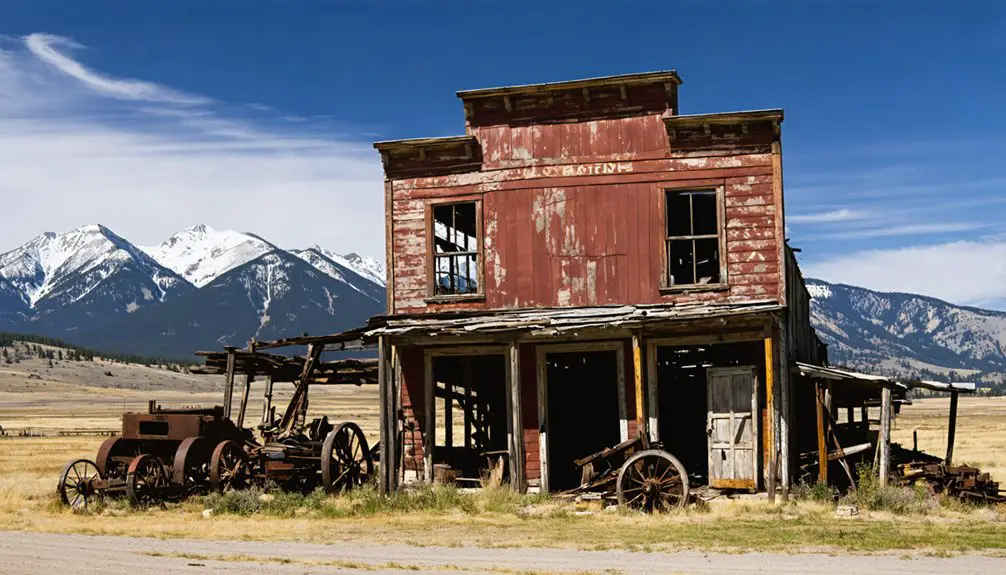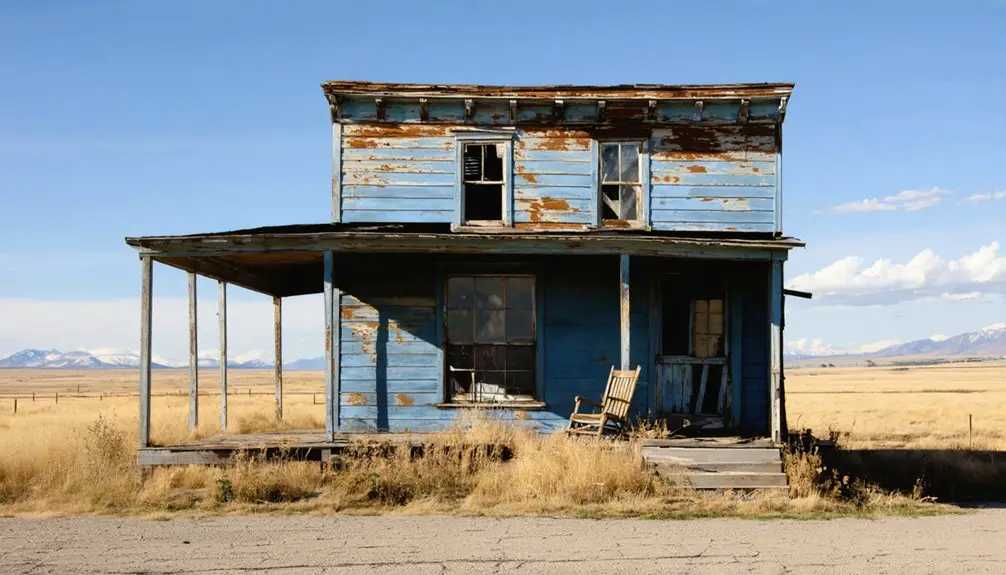You’ll find Keystone, a former mining boomtown, tucked away in Montana’s rugged terrain. In 1887, prospectors discovered rich silver galena deposits, quickly transforming the settlement from O’Rourke into Keystone. The population soared past 2,000 during its peak, making it Pennington County’s largest community. While mining operations thrived, the town gained notoriety during Prohibition for its hidden whiskey production in abandoned mines. Today’s weathered ruins and collapsed structures tell fascinating tales of frontier ambition.
Key Takeaways
- Initially established in 1887 after silver galena discoveries, Keystone grew into a bustling mining town with over 2,000 residents.
- The town thrived through gold mining operations, including the notable Keystone Mine and Holy Terror Gold Mine.
- During Prohibition, Keystone’s mines served as covers for underground whiskey production and bootlegging operations.
- Mining disputes, economic challenges, and the silver price crash of 1893 contributed to the town’s eventual decline.
- Today, visitors can explore weathered structures and mining remnants via dirt roads, as nature reclaims the abandoned settlement.
The Rise and Fall of a Mining Frontier
When prospectors discovered rich deposits of silver galena in Spring Gulch during the summer of 1887, they set off a chain of events that would transform this remote corner of Montana Territory.
The town initially thrived under the name O’Rourke before adopting its current name.
You’d have found a flurry of activity as miners rushed to stake claims like the Iron King, Silver Glance, and Keystone, though most walked away empty-handed.
The real boom didn’t hit until 1894, when William Franklin struck the Holy Terror gold vein, drawing thousands to this frontier outpost.
Through mining disputes and economic fluctuations, you’d have witnessed Keystone’s explosive growth to over 2,000 residents, making it Pennington County’s largest settlement.
The arrival of the railroad in 1900 marked a significant turning point for the mining community.
But like many Western boomtowns, the prosperity wouldn’t last.
From O’Rourke to Keystone: A Town’s Evolution
You’ll find that O’Rourke’s changeover to Keystone began with the establishment of a post office in 1891, when Senator Thomas Carter briefly secured the name “Carter” for the settlement.
The town’s shifting identity reflected its evolution from a simple mining camp to an organized community with essential services, including hotels, schools, and a miners union hall.
Mining operations expanded westward toward Slowey Creek, transforming the settlement pattern from a cluster of basic claims into a more structured frontier town centered around the productive silver deposits. The discovery of quartz gold in 1887 marked the beginning of the town’s mining prosperity.
Post Office Spurs Change
The establishment of a post office in 1891 catalyzed significant changes for the mining settlement of O’Rourke, transforming it from a modest camp into the more formally recognized town of Carter.
You’ll find this shift wasn’t merely administrative – the postal service presence marked a vital turning point in community identity, as the town adopted Senator Thomas Carter’s name to secure its official status.
During this period, you’d have witnessed the town’s peak population surpass 300 residents, with the post office serving as both communication hub and economic indicator.
When silver prices crashed in 1893, the town’s fortunes followed suit. The post office’s subsequent closures and reopenings between 1894 and 1904 reflected the broader economic struggles of this Montana mining community.
Historic photographs from the Northern Pacific Railroad depots capture the changing landscape of this once-bustling mining town.
Mining Transforms Settlement Pattern
As five prospectors ventured into Spring Gulch during the summer of 1887, their discovery of rich silver galena deposits sparked a transformation that would reshape Montana’s mining landscape.
You’d have witnessed a dramatic shift in settlement demographics as Phil O’Rourke’s grubstake funding led to the first organized mining techniques in the region.
Similar to the success of the Copper Kings in Butte, this area attracted significant investment and development.
The area’s development unfolded through distinct phases:
- Initial scattered claims along Spring Gulch, with prospectors filing the Iron King, Iron Queen, and other notable sites
- O.R. & N mine’s success drawing more settlers with its impressive 150 oz silver yields
- Evolution from isolated mining camps to a structured community
- Emergence of corporate mining operations that brought advanced extraction methods
Much like the historic Drumlummon Mine sale of 1883 that transformed Montana’s economy, this systematic transformation turned a remote gulch into a bustling mining settlement, forever changing Montana’s territorial landscape.
Mining Operations and Mineral Wealth
Mining prospects in Keystone first emerged during 1887 when five prospectors, financially backed by Phil O’Rourke, discovered promising claims along Spring Gulch.
You’ll find their initial mineral extraction efforts yielded impressive results, with silver galena ore assaying at 150 ounces of silver and 58% lead.
Mining innovation reached new heights when the Keystone Mine opened in 1891, delivering ore worth $2.50 per pan.
The operation expanded with a 20-stamp mill in 1892, and strategic developments continued when the Keystone and Holy Terror mines connected via drift in 1898.
While ownership changed hands several times, from the Keystone Mining Company to the Holy Terror Gold Mine, the region’s rich deposits of silver, lead, and copper sustained operations throughout the late 19th century.
The mine’s 3,520-foot elevation facilitated extensive underground workings.
Records show Par-D Mining later became one of the primary owners of the operation.
A tragic incident occurred in 1901 when three miners died after being exposed to toxic gas from a malfunctioning compressor at the Holy Terror Mine.
Life During the Prohibition Era
During Prohibition, you’d find Keystone’s mining operations served a dual purpose, with the “New Idea” mine functioning as both a copper excavation site and a clever front for whiskey production.
Behind the legitimate facade of mineral extraction, bootleggers transformed underground mining chambers into secret distilleries, utilizing copper equipment to produce high-quality spirits for distribution throughout Eastern Idaho. Women bootleggers helped sustain their families by participating in the underground alcohol trade. Like many mining towns, Keystone’s law enforcement overlooked most violations, allowing the illegal alcohol economy to thrive.
You can trace how the established transportation routes, originally created for ore shipments, became perfect conduits for smuggling illegal alcohol, while corrupt local law enforcement often looked the other way in exchange for bribes.
Bootlegging Behind Mine Operations
Life behind Keystone’s mine operations took on a rebellious edge when Montana voters approved statewide prohibition in 1916.
Female bootleggers emerged as key players in the underground economy, operating speakeasies and roadhouses while targeting miners’ homes to maintain steady demand.
The “wide open” drinking culture persisted despite prohibition, with bootlegging becoming deeply integrated into Keystone’s daily operations:
- Miners relied on bootleggers to maintain their traditional drinking lifestyle
- Home distilling operations, often run by working-class women and widows, supplemented family incomes
- The Anaconda Copper Company opposed prohibition enforcement to keep worker morale high
- Smuggling networks used modified vehicles on the Bootlegger Trail to transport Canadian liquor
The rugged terrain and remote location made enforcement nearly impossible, allowing the illicit trade to flourish behind mine operations.
Secret Distillery Underground Network
While Montana’s statewide prohibition created challenges for drinkers above ground, a sophisticated network of underground distilleries emerged beneath Keystone’s streets and buildings in 1916.
You’d find these hidden operations connected by a maze of tunnels and cellars, where distillers crafted small batches of spirits using makeshift equipment. Women played a vital role in running these underground distilleries, facing lighter penalties if caught.
Local speakeasy culture thrived through discreet communication networks and trusted contacts. You couldn’t just walk into these establishments – you needed to know the right people and secret signs.
Law enforcement often looked the other way, accepting bribes to protect the operations. Despite the risks of federal raids, these underground networks provided essential economic support for mining communities that openly rejected prohibition’s constraints.
Hartman’s Copper Mining Front
In a clever scheme that fooled local authorities, John E. Hartman transformed an abandoned copper mine into a profitable underground distillery during Prohibition.
After filing a claim on the Emmet Mine in Keystone by 1925, he orchestrated a copper facade while operating an illicit still beneath the surface.
Here’s how Hartman maintained his deceptive operation:
- Used copper tubing disguised as mining equipment to construct his distillery
- Claimed discovery of overlooked copper ore seams to justify mining activity
- Transported alcohol under the guise of ore shipments to Idaho smelters
- Selected an isolated, abandoned mine to avoid unwanted attention
The operation proved highly successful until 1930, when Hartman abruptly withdrew his funds and vanished, leaving behind exposed evidence of his ingenious Prohibition-era enterprise that had supplied eastern Idaho’s black market.
What Remains: Exploring the Ghost Town Today
Today, visitors to Keystone, Montana encounter a haunting tableau of wooden structures slowly succumbing to time and elements.
You’ll find ghostly remnants of what was once a bustling mining community – collapsed roofs, weathered timbers, and foundational footprints of the Hotel Vendome, boarding houses, and miners’ union hall scattered across the remote landscape.
You can reach these historic ruins via dirt roads suitable for off-road vehicles, though you’ll need to explore the remaining structures on foot.
While there’s minimal signage to guide your journey, the site’s isolation and eerie atmosphere create uniquely personal visitor experiences.
One occupied house stands as the sole reminder of human habitation, while nature steadily reclaims the surrounding terrain, transforming this once-vibrant town into a silent memorial to Montana’s mining era.
Legacy of the Montana Mining Boom

Montana’s legendary mining boom, sparked by the 1858 gold discovery near Drummond, transformed a rugged territory into an economic powerhouse that shaped the American West.
The mining legacies you’ll find across the state tell a story of remarkable economic transformations, from gold strikes to silver veins to copper empire.
Montana’s mineral wealth sparked waves of transformation, as prospectors chased dreams from gold fields to silver lodes to copper mines.
You can trace these profound changes through:
- The rise of iconic towns like Bannack, Virginia City, and Helena, which emerged from simple mining camps
- The development of industrial-scale operations that turned Butte into “The Richest Hill on Earth”
- The arrival of railroads and modern infrastructure that connected Montana to national markets
- The establishment of social movements and labor activism that shaped workers’ rights
These mining legacies continue to influence Montana’s identity, from its preserved ghost towns to its enduring industrial heritage.
Frequently Asked Questions
Are There Any Documented Paranormal Activities or Ghost Sightings in Keystone?
You won’t find officially documented ghostly encounters or spirit sightings here. While visitors report uneasy feelings and an eerie atmosphere at dusk, there’s no concrete evidence of paranormal activity in the area.
What Happened to the Original Residents After the Town’s Decline?
You’ll find the original inhabitants scattered across Montana and beyond, pursuing new mining prospects, farming opportunities, or urban work. Some stayed nearby, while others preserved the town’s legacy through historical societies.
How Dangerous Is It to Explore the Remaining Structures Today?
Want to risk your life for adventure? You’ll face severe structural safety concerns in these deteriorating buildings, with hazards from collapsing floors, hidden mine shafts, and unstable debris making exploration highly dangerous.
Were There Any Notable Crimes or Violent Incidents During Keystone’s Peak?
You won’t find documented murder mysteries or major violent incidents from Keystone’s peak. While frontier law enforcement was minimal, historical records don’t indicate any notorious crimes beyond typical mining-era disputes.
What Native American Tribes Originally Inhabited the Keystone Area?
Like ancient spirits echoing through time, you’ll find the Crow tribe primarily claimed this land, while Blackfeet and Salish peoples also moved through the region during seasonal hunting migrations.
References
- https://www.youtube.com/watch?v=lJy7Q8kNbGU
- https://glaciermt.com/ghost-towns
- https://www.historynet.com/keystone-montana-ghost-town/
- https://www.historicalfx.com/videos/v/kdywh9m77gdhl7ya9c9bapnkkmspz9
- https://www.youtube.com/watch?v=UZjLJD8_gbs
- https://blackhillsvisitor.com/learn/the-story-of-keystone/
- https://archiveswest.orbiscascade.org/ark:/80444/xv28731
- https://en.wikipedia.org/wiki/History_of_Montana
- https://archives.colorado.gov/collections/historic-mine-reports
- https://npshistory.com/publications/hcrs/butte.pdf



